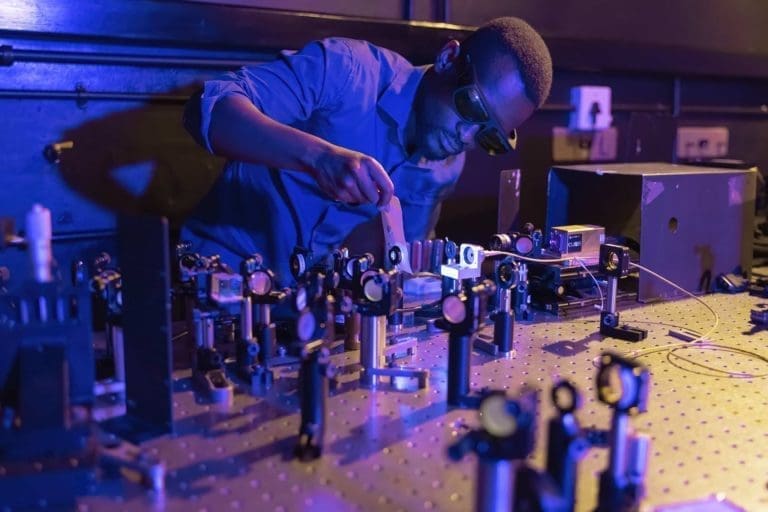Isaac Nape, an emerging South African talent in the study of quantum optics, is part of a crack team of Wits physicists who led an international study that revealed the hidden structures of quantum entangled states. The study was published in the renowned scientific journal, Nature Communications, on Friday, 27 August 2021.
Nape is pursuing his PhD at Wits University and focuses on harnessing structured patterns of light for high dimensional information encoding and decoding for use in quantum communication.
Earlier this year he scooped up two awards at the South African Institute of Physics (SAIP) conference to add to his growing collection of accolades in the field of optics and photonics. He won the award for ‘Best PhD oral presentation in applied physics’, and jointly won the award for ‘Best PhD oral presentation in photonics’.
In May, he was also awarded the prestigious 2021 Optics and Photonics Education Scholarship from the SPIE, the international society for optics and photonics, for his potential contributions to the field of optics, photonics or related field.
Faster and more secure computing
Now Nape and his colleagues at Wits, together with collaborators from Scotland and Taiwan offer a new and fast tool for quantum computing and communication. “Quantum states that are entangled in many dimensions are key to our emerging quantum technologies, where more dimensions mean a higher quantum bandwidth (faster) and better resilience to noise (security), crucial for both fast and secure communication and speed up in error-free quantum computing.
“What we have done here is to invent a new approach to probing these ‘high-dimensional’ quantum states, reducing the measurement time from decades to minutes,” Nape explains.
Nape worked with Distinguished Professor Andrew Forbes, lead investigator on this study and Director of the Structured Light Laboratory in the School of Physics at Wits, as well as postdoctoral fellow Dr Valeria Rodriguez-Fajardo, visiting Taiwanese researcher Dr Hasiao-Chih Huang, and Dr Jonathan Leach and Dr Feng Zhu from Heriot-Watt University in Scotland.
Are you quantum or not?
In their paper titled: Measuring dimensionality and purity of high-dimensional entangled states, the team outlined a new approach to quantum measurement, testing it on a 100 dimensional quantum entangled state.
With traditional approaches, the time of measurement increases unfavourably with dimension, so that to unravel a 100 dimensional state by a full ‘quantum state tomography’ would take decades. Instead, the team showed that the salient information of the quantum system – how many dimensions are entangled and to what level of purity? – could be deduced in just minutes. The new approach requires only simple ‘projections’ that could easily be done in most laboratories with conventional tools. Using light as an example, the team using an all-digital approach to perform the measurements.
The problem, explains Nape, is that while high-dimensional states are easily made, particularly with entangled particles of light (photons) they are not easy to measure – our toolbox for measuring and controlling them is almost empty.
You can think of a high-dimensional quantum state like faces of a dice. A conventional dice has 6 faces, numbered 1 through 6, for a six-dimensional alphabet that can be used for computing, or for transferring information in communication. To make a ‘high-dimensional dice’ means a dice with many more faces: 100-dimensions equals 100 faces – a rather complicated polygon.
“In our everyday world it would be easy to count the faces to know what sort of resource we had available to us, but not so in the quantum world. In the quantum world, you can never see the whole dice, so counting the faces is very difficult. The way we get around this is to do a tomography, as they do in the medical world, building up a picture from many, many slices of the object,” explains Nape.
But the information in quantum objects can be enormous, so the time for this process is prohibitive. A faster approach is a ‘Bell measurement’, a famous test to tell if what you have in front of you is entangled, like asking it “are you quantum or not?”. But while this confirms quantum correlations of the dice, it doesn’t say much about the number of faces it has.
Chance discovery
“Our work circumvented the problem by a chance discovery, that there is a set of measurements that is not a tomography and not a Bell measurement, but that holds important information of both,” says Nape. “In technical parlance, we blended these two measurement approaches to do multiple projections that look like a tomography but measuring the visibilities of the outcome, as if they were Bell measurements. This revealed the hidden information that could be extracted from the strength of the quantum correlations across many dimensions”.
First and fast
The combination of speed from the Bell-like approach and information from the tomography-like approach meant that key quantum parameters such as dimensionality and the purity of the quantum state could be determined quickly and quantitatively, the first approach to do so.
“We are not suggesting that our approach replace other techniques,” says Forbes. “Rather, we see it as a fast probe to reveal what you are dealing with, and then use this information to make an informed decision on what to do next. A case of horses-for-courses”.
For example, the team see their approach as changing the game in real-world quantum communication links, where a fast measurement of how noisy that quantum state has become and what this has done to the useful dimensions is crucial.

